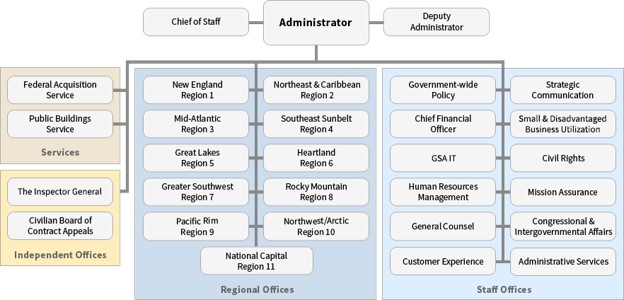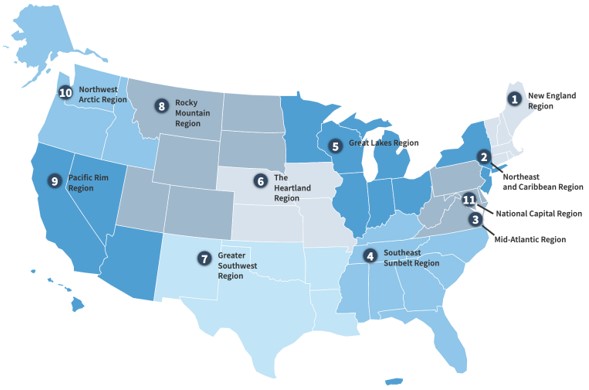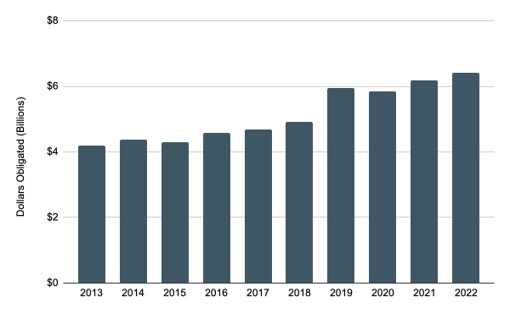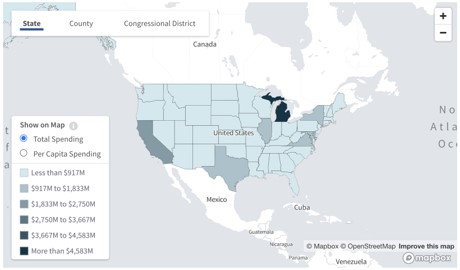As the central procurer of the federal government, the General Services Administration (GSA) holds massive responsibility and accountability to all U.S. federal government branches and vendors. GSA manages, maintains, and regulates federal real estate and facilities, vehicles, governmentwide contracts, products, travel, services, information technology (IT), and more. In addition, being a member of the Federal Acquisition Regulation (FAR) Council, GSA assists in developing all federal regulations on acquiring and procuring supplies and services.
History, Mission, and Organization
The Federal Property and Administrative Services Act led to the formation of GSA under President Harry Truman in 1949. This establishment consolidated the National Archives Establishment, the Federal Works Agency, the Public Buildings Administration, the Bureau of Federal Supply, the Office of Contract Settlement, and the War Assets Administration.
In the spirit of the Act, GSA’s original mission was to dispose of war surplus goods, manage and store federal government records, handle emergency preparedness, and stockpile strategic supplies for wartime. Since the original implementation, GSA’s mission has vastly expanded into four major program areas:
- Real estate, including construction and facility management
- Acquisition services, including Assisted Acquisition Services (AAS)
- Technology, including management of the Technology Modernization Fund (TMF)
- Government operations, including White House support
Through two national services offices (Public Buildings Service [PBS] and Federal Acquisition Service [FAS]), 12 staff offices, and 11 regional service offices, GSA provides workspace to more than one million federal civilian workers, oversees the preservation of more than 480 historic buildings, and facilitates every department/branch of the federal government, including 50 independent agencies, tribal nations, and state and local governments, in the procurement of various products and services totaling more than $84B in assisted acquisitions annually.
GSA organizes several services that benefit U.S. citizens and consumers. These services include promoting the accessibility of facilities and technology; implementing environmental and urban development community programs; assisting in security and emergency response; and supplying the military, law enforcement, and rescue organizations through state and local governments.
GSA’s Administrator oversees a federal agency of approximately 11,600 people and an annual budget of roughly $16B and growing. The Administrator heads one of three central management agencies in the federal government.

A vital support system of the Administrator is the GSA Acquisition Policy Federal Advisory Committee (GAP FAC). The GAP FAC advises the Administrator on the best use of its resources to address federal acquisition challenges. The Office of General Services Acquisition Policy, Integrity & Workforce is responsible for GSA-wide acquisitions. This office handles policy development and compliance, takes action against problematic contractors, and executes strategy. It comprises four divisions:
- The Procurement Management Review Division (PMRD) assesses GSA’s acquisition centers and activities. It maintains compliance with statutory, regulatory, policy, and sound business regulations practices. PMRD also identifies acquisition weaknesses on the transactional and entity level and prepares acquisition centers for audits.
- The GSA Policy Division revises GSA’s addition to the FAR, the GSA Acquisition Manual (GSAM). It is also responsible for meeting any applicable reporting requirements.
- The Acquisition Workforce Division focuses on the professional development of the GSA acquisition workforce. This work includes organizing human capital efforts and federal acquisition certification programs. The Acquisition Workforce Division also manages GSA’s Contracting Officer Warrant Program (COWP).
- The Suspension & Debarment Division processes suspension and debarment cases, issues agency protest decisions, and handles complaints, justification and approval requests, sole source approvals, requests for waivers, and organizational conflict of interest issues.
In addition to GSA’s national/regional office in Washington, DC, GSA also has ten regional offices in Boston, MA; New York, NY; Philadelphia, PA; Atlanta, GA; Chicago, IL; Kansas City, MO; Fort Worth, TX; Denver, CO; San Francisco, CA; and Tacoma, WA.

GSA in Action
GSA has undertaken a few programs and initiatives that benefit the federal workforce, facilitate government operations, and provide services to U.S. citizens.
Bipartisan Infrastructure Law (BIL) Construction Projects
Recently, Congress allocated $3.5B to GSA to modernize 26 Land Ports of Entry (LPOEs) at U.S. northern and southern borders. In conjunction with the Department of Homeland Security (DHS) and Customs and Border Protection (CBP), the program will eventually include over 50 projects divided into four categories:
- Major modernizations
- Paving replacements
- Lease purchases
- Federal Motor Carrier Safety Administration (FMCSA) locations
The projects are located in 12 states across seven GSA regions. For reference, there are 167 LPOEs across America’s borders. GSA owns and operates 102 facilities (61%) and leases another 22 (13%). For more detailed information, visit GSA’s BIL website.
21st Century Integrated Digital Experience Act (IDEA)
The 21st Century IDEA aims to improve the digital experience for government customers and reinforces existing requirements for federal public websites. As one of the primary actors in the federal government, GSA co-led the Customer Experience (CX) Cross-Agency Priority (CAP) Goal and improved their shared digital services offerings, including Cloud.gov, Digital Analytics Program (DAP), DotGov, FedRAMP, Login.gov, Search.gov, and U.S. Web Design System (USWDS).
GSA also published the ICT Accessibility Testing Baseline, adopted as a best practice by the Federal CIO Council’s Accessibility Community of Practice (ACOP) and Digitaldashboard.gov. This government-only site reports on critical metrics for conformance and compliance with various IT standards and requirements.
GSA Smart Buildings Program
The GSA Smart Buildings Program is a technology framework designed to lower operating costs, improve cyber security, and increase tenant satisfaction. This program has several offshoot projects and results.
- GSAlink is a fault detection and diagnostics system that tracks operational data to improve efficiency. The program allows facility managers and contractors to effectively manage building operations using building data. This framework can also record energy consumption levels using advanced metering technology.
- National Digital Signage (NDS) kiosks provide information on facility news, weather, human trafficking, and information on missing and exploited children.
- The National Computerized Maintenance Management System (NCMMS) offers building logistics such as equipment management, work orders, preventive maintenance, and labor.
Presidential Transitions
During a Presidential transition, GSA supports eligible candidates, President-elect and Vice-President-elect, inter-agency transition efforts, Presidential Inauguration, and the outgoing President and Vice-President. This can include providing office space for candidates while they prepare to hold office.
GSA also offers fully-equipped office space, parking, fleet vehicles, mail management, payment of compensation for office staff, expenses for the procurement of experts or consultants and communication services, and payment of travel, subsistence, printing, and postal to the President-elect, Vice-President-elect, outgoing President, and outgoing Vice-President.
The Federal Transition Coordinator ensures that the federal government has an integrated strategy for addressing inter-agency challenges and responsibilities around Presidential transitions and the turnover of non-career appointees.
Preservation of Historic Federal Properties: Filming on Location
The GSA Center for Historic Buildings runs a nationwide program that promotes using historic buildings in movies and television. GSA’s Filming on Location Initiative is based on the National Historic Preservation Act (NHPA) of 1966 and the Public Buildings Cooperative Use Act. It allows the public to experience these buildings through film. Interested parties contact their Regional Historic Preservation Office (RHPO) and submit a proposal for filming. GSA enforces guidelines to preserve the buildings. Furthermore, all revenue earned through this program is reinvested in the historical inventory, such as on repairs.
Contract Procurement and Acquisition
As the federal government’s purchasing agent, GSA connects federal purchasers with commercial products and services. This means that GSA serves as the contracting agent or authority, not the funding agency, or that funding agencies can buy what they need through any of the GSA’s purchasing programs outlined in our previous FAS article.
It is important to note that while GSA leverages its purchasing programs to assist other federal agencies, the agency also utilizes these programs to acquire its services, products, and solutions.
As for direct service, GSA buys the following in support of their internal initiatives and needs:
- Architecture and Engineering
- Design and Construction
- Facilities Maintenance & Management
- Fleet and Automotive
- Leasing
- Green / Energy
- Information Technology
- Retail Services
- Childcare
- Realty Services
- Real Estate Services
- Real Property Disposal
- Travel
- Professional Services
- Miscellaneous
Recent Contracts
Spending Trends
The following spending trends are based on federal contract awards funded by GSA. It is important to note that the following statistics and spending trends information presented below are solely focused on internal GSA initiatives and do not cover where GSA has awarded assistance to external agencies.
Over the previous ten fiscal years, GSA has funded between $4 and $6B per year in contracts to meet their requirements. Spending peaked in FY22 at $6.4B.

Most of the contract work is performed in Michigan, California, Virginia, Maryland, New York, Illinois, and Texas.

Based on the most commonly used PSCs and NAICS Codes, GSA spends most of its contract dollars on maintaining office buildings, vehicles, and IT. GSA Multiple Award Schedule (MAS) is the agency’s most used procurement vehicle.
Top 10 U.S. Federal Contractors (FY18-FY22):
- Ford Motor Co.
- FCA US LLC
- General Motors LLC
- W.W. Grainger, Inc.
- Fleet Vehicle Source Inc.
- Brasfield & Gorrie, L.L.C.
- Hensel Phelps Construction Co.
- Brasada Ford LTD
- Volmar Construction Inc.
- Booz Allen Hamilton Inc.
Top 10 PSCs (FY18-FY22):
- 2310 – Passenger Motor Vehicles
- Z2AA – Repair or Alteration of Office Buildings
- Z1AA – Maintenance of Office Buildings
- Y1AA – Construction of Office Buildings
- S201 – Housekeeping – Custodial Janitorial
- 5120 – Hand Tools, Nonedged, Nonpowered
- 2320 – Trucks and Truck Tractors, Wheeled
- D399 – IT and Telecom – Other IT and Telecommunications
- R499 – Support – Professional: Other
- 7510 – Office Supplies
Top 10 NAICS Codes (FY18-FY22):
- 236220 – Commercial and Institutional Building Construction
- 336111 – Automobile Manufacturing
- 561210 – Facilities Support Services
- 561720 – Janitorial Services
- 541512 – Computer Systems Design Services
- 541519 – Other Computer-Related Services
- 541330 – Engineering Services
- 336112 – Light Truck and Utility Vehicle Manufacturing
- 444110 – Home Centers
- 541611 – Administrative Management and General Management Consulting Services
GSA in 2023 and Beyond
GSA’s FY23 Annual Performance Report outlines GSA’s priority goals and strategic objectives. Its goals are to right-size its real estate portfolio, address the climate crisis through zero-emission fleet vehicles, and increase the adoption of GSA-sponsored identity solutions. Its strategic objectives are to:
- Modernize agency infrastructure to include the effective adoption of shared technology solutions and virtual workplace options.
- Bolster the supply chain to the U.S. Government in 2025 and beyond to maximize opportunities for small and underserved businesses and enhance economic activities in underserved communities.
- Ensure GSA’s offerings meet market demand for products, services, and solutions, including an increased focus on customer experience with technology and digital platforms.
- Support effective and efficient government operations through workforce policy reform, climate risk mitigation, and interagency collaboration.
GSA received $43.6B in budgetary resources for FY23 and plans to spend $4.4B on contract awards. $90M has been allocated to the Federal Citizen Services Fund to encourage the conduct of activities electronically and support innovative technology uses. The Federal Buildings Fund (FBF) is getting $10B. Additionally, GSA focuses on two pillars of the National Strategy on Hunger, Nutrition, and Health: to empower all consumers to make and have access to healthy choices and to support physical activity for all.
In February 2023, GSA also announced the Applied AI Healthcare Challenge. The competition will award prizes to anyone who can propose practical solutions for improving outcomes in mental health, addiction, equity, supply chain, and cancer. The Challenge is being managed by the Centers of Excellence and will announce four winners in May.
Most of the anticipated awards in 2023 will come from FAS and PBS, according to GSA’s FY23 contract opportunity forecast. Most are for commercial and institutional building construction, facilities support, and janitorial services.
GSA’s Strategic Plan for FY22 to FY26 provides insight into its long-term goals:
- Financially and environmentally sustainable, accessible, and responsive workspace solution that enable a productive federal workforce;
- A modern, accessible, and streamlined acquisition ecosystem and a robust marketplace connecting buyers to the suppliers and businesses that meet their mission needs;
- A digital government that delivers for the public through trusted, accessible, and user-centered technologies; and
- A government that capitalizes on interagency collaboration and shared services to make informed management decisions and improve operations, delivering value for the American people.
From the 2022 Annual Report, GSA recognizes its challenges in delivering a better digital experience. These challenges center around coordinating across many platforms and better curating content, prioritizing digital communication between stakeholders at all levels. In addition, GSA has started experimenting with more incremental and streamlined funding approaches to projects to encourage low-risk, low-cost investments and kicked off a working group in 2022 to address improvements on how to structure contracts and post-award management for better agile development.
Per the Assessment of GSA’s Management and Performance Challenges for FY 2023, the OIG prepared an assessment summarizing the most significant management and performance challenges facing GSA in Fiscal Year 2023. They found challenges in the following eight areas.
- Establishing and Maintaining an Effective Internal Control Environment. OIG identified the following internal control deficiencies: Significant Deficiencies in Multiple Award Schedule Pricing, Significant Deficiencies with Air and Water Quality in Re-Opened GSA Facilities, and Significant Deficiencies in Internal Control Identified by GSA’s Independent Auditors.
- Improving Contract Administration. Contract administration includes monitoring contractor performance against contract terms, reviewing and approving payment requests, addressing change orders, and closing out contracts. OIG found contract administration challenges via various audits.
- Enhancing Government Procurement. Challenges included Transforming the MAS Program; Supply Chain Risk Management; Implementing Procurement Through Commercial E-Commerce Portals; and Leading the Transition to the Enterprise Infrastructure Solutions Contract.
- Maximizing the Performance of GSA’s Real Property Inventory. Challenges included Reducing and Consolidating Space; Reducing Leasing Costs; Meeting the Maintenance and Repair Needs of Federal Buildings; Administering GSA’s Capital Construction Program; and Ensuring Effective Management of Energy Savings Performance Contracts and Utility Energy.
- Managing Agency Cybersecurity Risks. GSA will continue to be challenged in effectively monitoring and efficiently identifying and responding to cyber threats against Agency systems and data. GSA will have to continuously identify technical solutions and implement controls to mitigate such threats as bad actors find new ways to penetrate and navigate government networks and systems undetected. Challenges include Controlling Access to GSA Systems and Sensitive Information, Prioritizing Cyber Supply Chain Risk Management, and Migrating to a Zero Trust Architecture.
- Safeguarding Federal Facilities and Providing a Secure Work Environment. Reports demonstrate an ongoing need for GSA management to pay attention to the safety and security of federal facilities. In particular, recent audits and inspections have found problems with GSA’s management of building safety measures and enforcement of security protocols, such as GSA’s Management of Building Safety; and Security Deficiencies in GSA Facilities.
- Managing the Electrification of the Federal Fleet. GSA is challenged to find available zero-emission vehicles and secure sufficient funding to replace its fleet. Current infrastructure is not adequate to accommodate widespread electric vehicle use, so GSA’s Fleet Management and PBS offices will have to work together to expand the electric vehicle charging infrastructure rapidly.
- Managing the Impact of COVID-19. First, GSA must consistently implement return-to-facilities guidance. Second, GSA must ensure that HVAC systems provide adequate ventilation to minimize the spread of the virus. Third, GSA must ensure that clean water is available in facilities where decreased occupancy and water use may have caused water to stagnate, increasing the risk of water contamination.
GSA will also have to address problems with Best-In-Class contracts (BICs), GWACs that are considered the best of their kind in terms of management and data practices. MAS, GSA 8(a) STARS III, and NASA SEWP V are all examples of BICs. However, there is no updated list of what the federal government has deemed to be a BIC. BICs often have problems regarding simplified acquisition procedures and equal and open competition and opportunity. BICs lead to less fully open acquisition opportunities and sources, and it is common to have the same contractors on multiple BICs. As a result, vendors are merging or subcontracting more frequently to meet the requirements to get on BICs. GSA also sees a decline in small business vendor utilization in BICs since 2019. GSA must figure out how to appease industry and government by being as accessible yet efficient as possible.
On the docket in 2023 are two major GSA-run contracts: Polaris, a traditionally-defined GWAC, and RIO, a vehicle aimed at supporting companies who have completed a Stage 3 SBIR and are now aiming to win a contract that will enable them to enter the production phase. Since mid-2022, GSA has conducted 12 industry events across the country to speak with Stage 3 SBIR companies and better understand the challenges that might be addressed by a vehicle like RIO. The request for information remains active on SAM.gov.
Polaris has faced its fair share of challenges in implementation, facing several pre-award protests. When ultimately awarded, the contract will facilitate IT awards to companies in four categories: small businesses, woman-owned small businesses (WOSB), HUBZone Certified firms, and service-disabled veteran-owned businesses (SDVOSB).
Researched and authored by Haley Boulanger, Pulse Analyst.
